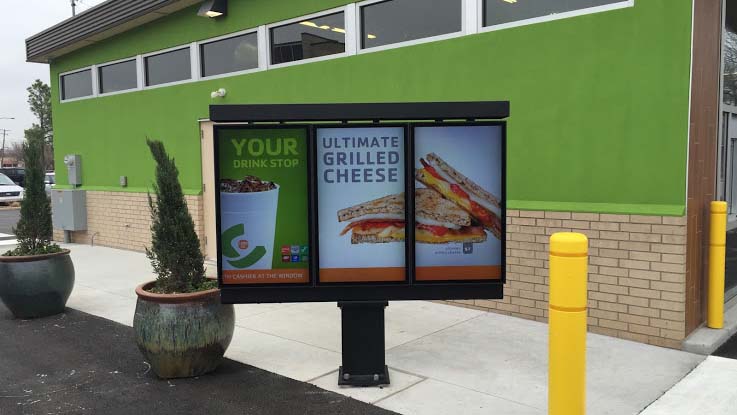Modernization Brings Changes to Drive-Thrus

The drive-thru has long been the chief point of sale for quick-service restaurants. Ten years ago, the drive-thru accounted for between 60 to 70 percent of food and beverage sales. One decade later, changing consumer habits and strict guidelines fueled through the pandemic have escalated its importance and value.
Post-lockdown, many QSRs have sharply reduced interior counter service hours, with intermittent closings as local case numbers surged. These changes, along with the safety of being inside the car, have sparked some drive-thru sales to increase by another 30 percent, accounting for most of the customer revenue. Others never re-opened their lobbies, relying exclusively on drive-thru service.
[Download the Digital Signage Best Practices Guide]
The QSR industry expects these changing consumer habits and business operations to continue post-pandemic. This is a primary reason why so many QSRs are digitizing their drive-thru models, from wider dual-lane lane designs to more dynamic menu and ordering systems.
These are not completely novel updates, as many of today’s most well-known QSRs are working through multi-year upgrades across their chains. USSI Global has served as the lead project manager for several digital menu board upgrades with household-name QSRs, including 1,200 locations in 25 states for one globally known brand. This project coincided with the chain’s transition to a dual lane ordering system, with USSI Global managing all logistics and more than 200 teams of system integrators that installed over 7,200 displays. The relationship with the system integrator is ultimately what creates a successful and uniform result across so many locations.
As perhaps the most important role of the project management company, logistics are critical to the success of these extensive projects, which have unique characteristics and more complex phases then most digital signage rollouts. To begin, the outdoor redesign requires close liaising with local municipalities to secure permits, comply with local laws, and meet construction deadlines. There are also substantial foundational infrastructure changes that come with lane redesigns and modern menu board structures.
[The State of Digital Signage in 2021]
A daily selection of the top stories for AV integrators, resellers and consultants. Sign up below.
It’s imperative that all these elements come together under tight deadlines to properly manage budgets and follow the QSR’s exacting specifications to drive customer engagement, simplify menu changes, properly reflect brand image, and—most importantly—increase customer receipts.
Then there are the dynamic menu board themselves—the protective displays and the digital signage software powering the content—that must be specified, installed, and commissioned with uniformity across most, if not all stores.
Technology Choices
The role of the project management company is to properly execute the customer’s vision while overseeing all logistics. The breadth of logistics could summon an article three times this length. Looking specifically at the technology, the logistics include specifying and procuring the menu board equipment that meet the customer objectives outlined in the previous paragraph.
Digital menu board systems bring together several core elements. Beyond the displays and software that bring the menu board and ordering systems to life, there are cameras, intercom systems, and even point of sale (PoS) software that must integrate within the ecosystem to ensure a pleasant and expedient customer experience.
The latter is especially important for ROI: Our customers that have modernized their systems report a 10-second decrease in each drive-thru journey. That time reduction, along with a visual presentation that invites, emphasizes fast absorption and readability. Customers often report an increase in receipts by up to 20 percent.
[Re-Harnessing the Signage Wave]
Recent advances in display technology have set the stage for many of the menu board technology overhauls we have seen over the past 12 to 24 months. While visual quality and performance are paramount to the customer experience, innovations in the display hardware itself have contributed to the overall progression we have seen.
Even the biggest QSR budgets have ceilings, and display protection has long been a budgetary concern for drive-thru system upgrades. The costs of switching from flip adders to displays would quickly escalate; each site required a protective outdoor enclosure for an indoor display, along with heating and cooling elements to moderate temperature.
The transition to self-contained screens has contained the expense. IP66-rated protection has rendered modern menu boards impermeable to elements, with “dust tight” designs that protect against pelting rains and powerful jets of water.
Readability becomes more critical as QSRs add more items to their menus and more detail to layouts, including advertisements that help to monetize the network. This means ensuring the appropriate font size and brightness based on the amount of content, the distance between driver and board, and the environmental position in relation to sunlight and related elements. A brightness specification of 2,500 nits makes the display perfectly legible in direct sunshine and is the suggested threshold to ensure that all content is legible.
The digital signage software choice ultimately drives the customer experience and carries an important responsibility for proper brand representation. In addition to dayparting menus and flexible content scheduling, the CMS is the portal for real-time price adjustments and, more recently, the presence of voice activation.
The CMS is also increasingly driving the customer order display, not to mention the ads and widgets (such as a weather ticker) that increasingly populate the display. While there are many digital signage software solutions that accommodate these requirements, we are now seeing a trend that extends the connectivity to third-party systems, such as the point-of-sale system, marketing analytics and business intelligence software, and back-office business systems.
The connectivity to market analytics and business intelligence software is an especially compelling trend that will help QSRs understand the performance of their ads and content, deliver more useful information for consumers, and create an overall better dynamic. All of these innovations are helping QSRs operate in a way that is more efficient and user-friendly to the point where they can manage their own networks and content.
David S. Christiano is the CEO of USSI Global and Chris Northrup is the company’s vice president of business development, digital signage solutions.
David S. Christiano is the CEO of USSI Global.

